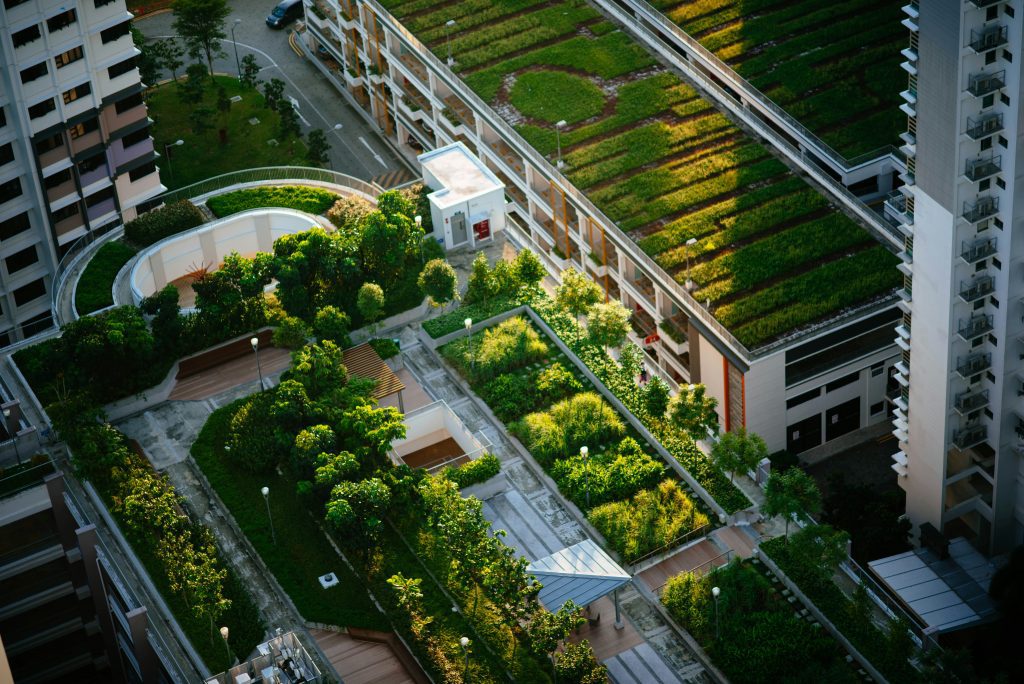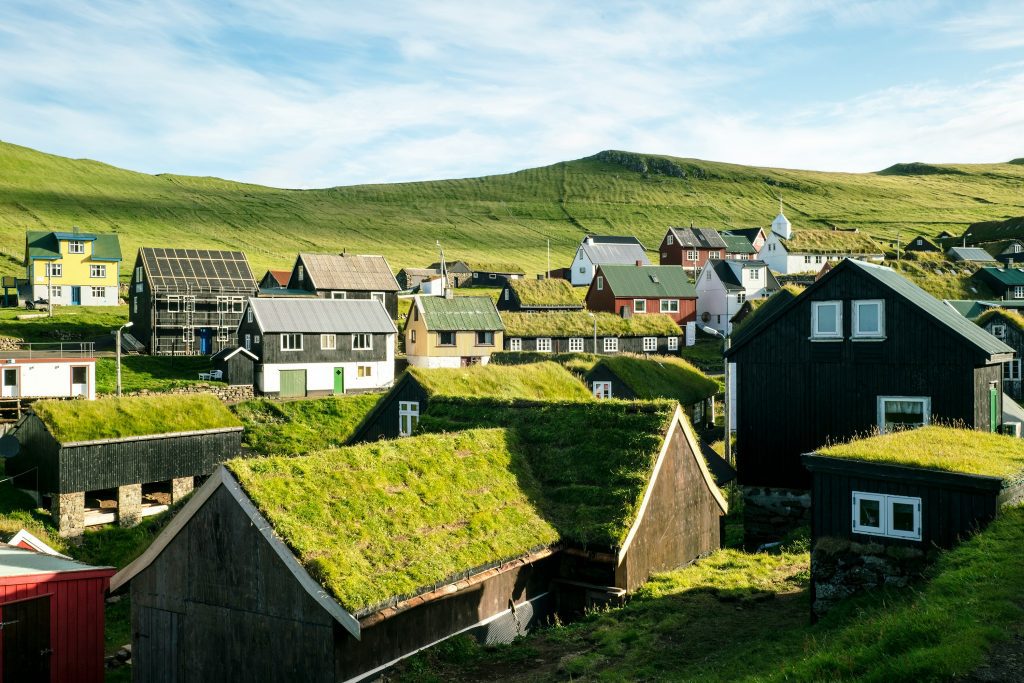Green roofs provide numerous environmental advantages that render them a valuable addition to any building. Firstly, they assist in reducing the urban heat island effect by offering a natural cooling effect through evapotranspiration. This is particularly significant in densely populated urban areas where the concentration of buildings and pavement can result in higher temperatures.
Moreover, green roofs can contribute to improved air quality by capturing airborne pollutants and carbon dioxide, and releasing oxygen through photosynthesis. This can positively impact the overall health and well-being of urban residents. Furthermore, green roofs can help mitigate the effects of climate change by reducing energy consumption for heating and cooling.
By providing an additional layer of insulation, green roofs can aid in regulating indoor temperatures, diminishing the need for artificial heating and cooling systems. This not only reduces energy consumption and greenhouse gas emissions but also helps to lower utility bills for building owners. Additionally, green roofs can help reduce stormwater runoff by absorbing and retaining rainwater, which can alleviate pressure on urban drainage systems and reduce the risk of flooding.
Overall, the environmental benefits of green roofs render them a sustainable and eco-friendly choice for any building.
Summary
- Green roofs reduce urban heat island effect and carbon emissions, contributing to environmental sustainability.
- They provide natural insulation, reducing the need for heating and cooling, and ultimately saving energy.
- Green roofs filter pollutants and CO2 from the air, improving overall air quality in urban areas.
- They absorb and slow down stormwater, reducing the risk of flooding and minimising strain on drainage systems.
- The protective layer of vegetation on green roofs can extend the lifespan of the roof membrane, reducing maintenance costs.
Energy Efficiency
Seasonal Benefits
In the summer, green roofs can help to keep buildings cool by providing shade and reducing the amount of heat absorbed by the roof. In the winter, green roofs can help to retain heat and prevent it from escaping through the roof, reducing the need for heating.
Long-term Cost Savings
In addition to reducing energy consumption for heating and cooling, green roofs can also extend the lifespan of a building’s roof membrane by protecting it from the elements. This can help to reduce maintenance costs and prolong the life of the roof, making green roofs a cost-effective investment in the long run.
A Sustainable Built Environment
Overall, the energy efficiency benefits of green roofs make them a valuable addition to any building, helping to lower energy consumption, reduce utility bills, and contribute to a more sustainable built environment.
Improved Air Quality

Green roofs can have a positive impact on air quality by capturing airborne pollutants and carbon dioxide, and releasing oxygen through the process of photosynthesis. This can help to improve the overall air quality in urban areas, which is particularly important in densely populated cities where air pollution is a major concern. By capturing pollutants such as particulate matter and nitrogen dioxide, green roofs can help to reduce the concentration of harmful substances in the air, leading to cleaner and healthier urban environments.
In addition to capturing pollutants, green roofs can also help to reduce the urban heat island effect by providing a natural cooling effect through evapotranspiration. This can help to lower temperatures in urban areas, reducing the formation of ground-level ozone and other harmful air pollutants. Overall, the improved air quality benefits of green roofs make them a valuable tool for creating healthier and more sustainable urban environments.
Stormwater Management
| Metrics | Data |
|---|---|
| Runoff Volume | 10,000 cubic metres |
| Water Quality Improvement | 80% reduction in pollutants |
| Flood Risk Reduction | 30% decrease in flood risk |
| Green Infrastructure | 50% of stormwater managed through green infrastructure |
Green roofs can help to reduce stormwater runoff by absorbing and retaining rainwater, which can help to alleviate pressure on urban drainage systems and reduce the risk of flooding. This is particularly important in urban areas where large amounts of impermeable surfaces such as pavement and buildings can lead to increased stormwater runoff. By capturing and retaining rainwater, green roofs can help to reduce the volume and velocity of stormwater runoff, which can help to prevent flooding and erosion in urban areas.
In addition to reducing stormwater runoff, green roofs can also help to improve water quality by filtering out pollutants from rainwater as it passes through the vegetation and growing medium. This can help to protect local waterways from contamination and reduce the impact of urban development on aquatic ecosystems. Overall, the stormwater management benefits of green roofs make them a valuable tool for creating more resilient and sustainable urban environments.
Extended Roof Lifespan
Green roofs can help to extend the lifespan of a building’s roof membrane by protecting it from the elements. By providing an additional layer of insulation and protection, green roofs can help to shield the roof membrane from temperature fluctuations, UV radiation, and mechanical damage. This can help to reduce wear and tear on the roof membrane, prolonging its lifespan and reducing maintenance costs for building owners.
In addition to protecting the roof membrane, green roofs can also help to reduce thermal expansion and contraction, which can lead to cracks and leaks in traditional roof systems. By providing a consistent temperature and moisture level, green roofs can help to prevent these issues and prolong the life of the roof membrane. Overall, the extended roof lifespan benefits of green roofs make them a cost-effective investment for building owners, helping to reduce maintenance costs and extend the life of their building’s roof.
Aesthetic Appeal

Transforming Urban Landscapes
By transforming unused roof space into vibrant gardens and green spaces, green roofs can create visually stunning landscapes that improve the overall appearance of buildings and contribute to a more attractive built environment. This can have a positive impact on property values and create more enjoyable spaces for building occupants and local residents.
Supporting Biodiversity
In addition to their visual appeal, green roofs can also provide habitat for birds, insects, and other wildlife in urban areas where natural habitats are limited. This can help to support biodiversity and create more ecologically diverse urban environments.
Creating Beautiful Urban Landscapes
Overall, the aesthetic appeal benefits of green roofs make them a valuable addition to any building, helping to create more beautiful and vibrant urban landscapes.
Potential Cost Savings
Green roofs can lead to potential cost savings for building owners by reducing energy consumption for heating and cooling, lowering utility bills, extending the lifespan of the roof membrane, and reducing maintenance costs. By providing an additional layer of insulation, green roofs can help to regulate indoor temperatures, reducing the need for artificial heating and cooling systems. This can lead to significant energy savings and lower utility bills for building owners.
In addition to energy savings, green roofs can also help to extend the lifespan of a building’s roof membrane by protecting it from the elements. This can reduce maintenance costs and prolong the life of the roof, making green roofs a cost-effective investment in the long run. Furthermore, green roofs can also provide potential cost savings through stormwater management by reducing the risk of flooding and alleviating pressure on urban drainage systems.
Overall, the potential cost savings associated with green roofs make them a valuable investment for building owners, helping to lower operating costs and create more sustainable buildings.
If you’re interested in learning more about the benefits of green roofing, you should check out the article “Exploring Green Roofs: Advantages and Applications” on Eco Friendly Home and Garden. This informative piece delves into the various advantages of green roofs, including their environmental benefits and energy-saving properties. It’s a great resource for anyone looking to understand the potential of green roofing in sustainable building design. You can find the article here.
FAQs
What are the benefits of green roofing?
Green roofing offers a range of benefits, including improved energy efficiency, reduced urban heat island effect, stormwater management, and increased biodiversity.
How does green roofing improve energy efficiency?
Green roofing can reduce the amount of heat absorbed by buildings, leading to lower energy costs for cooling in the summer and insulation in the winter.
What is the urban heat island effect and how does green roofing help to reduce it?
The urban heat island effect occurs when urban areas experience higher temperatures than surrounding rural areas. Green roofing can help to reduce this effect by absorbing and reflecting less heat than traditional roofing materials.
How does green roofing help with stormwater management?
Green roofing can absorb and retain rainwater, reducing the amount of stormwater runoff and alleviating pressure on urban drainage systems.
How does green roofing increase biodiversity?
Green roofing provides habitat for a variety of plants, insects, and birds, contributing to increased biodiversity in urban areas.
What are the environmental benefits of green roofing?
Green roofing can help to improve air quality, reduce carbon emissions, and mitigate the urban heat island effect, contributing to a healthier and more sustainable urban environment.


